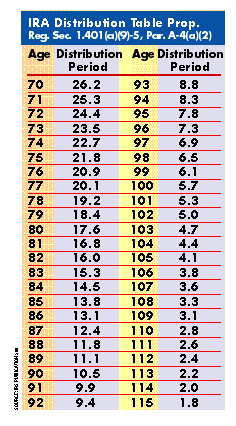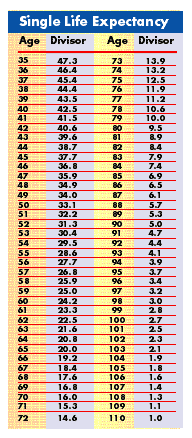
HOT TOPICS LIST
- Strategies
- Stocks
- Buy
- Investing
- Brokers
- Psychology
- Interviews
- Accumulate
- Sell
- Hold
- Spotlight
- Websites
- Candlestick Corner
- Gold & Metals
- Options Trading
LIST OF TOPICS
FINANCIAL PLANNING
How Do The New IRA Rules Affect You?
05/30/01 03:17:58 PM PSTby Morley Hudson
Thinking about taking out money from your IRA? If so, take heart. With the new 2001 required minimum distribution rules, it's easier than it used to be.
| On January 11, 2001, the Internal Revenue Service (IRS) issued new individual retirement account (IRA) distribution rules. These new rules replace the previous methods for determining IRA minimum distributions, and will have a great impact not only on IRA owners, but also on professional advisors whose clients own IRAs. The pre-2001 rules for IRA distributions were based on regulations first proposed in 1987, which produced a complex system with a virtually infinite number of possible combinations when it comes to distributions. Unfortunately, this complexity has led to confusion and uncertainty, and worst of all, lack of compliance. When a system becomes overly complicated, the potential becomes great for certified public accountants (CPAs) and account owners to err in calculating distributions. The IRS is aware of this, and thanks to the new rules, you can look forward to simplified distribution rules. The new rules will be optional for 2001 and mandatory for 2002. What do these new rules mean for you? IMPORTANT CHANGES Under the pre-2001 rules, the minimum distribution requirement varied with your age as well as the age of your designated beneficiary. The new 2001 rules propose a simple uniform life expectancy table to be used for all IRA owners, regardless of the age of your designated beneficiary. The only exception is if your spouse is more than 10 years younger than you, in which case a different life expectancy table must be used. With these new rules, you no longer have to decide whether to recalculate life expectancy annually. This was necessary under the 1987 proposed regulation method, where the potential for recalculating or not for both you and your designated beneficiary created four different options. Even with sophisticated software, it is difficult to rationally compare the benefits and detriments of these options. The new single table proposed in the 2001 rules allows the account owner to calculate the minimum distribution. It is now possible to change your beneficiary at any time. Under the pre-2001 rules, changing a beneficiary can lead to larger distributions. Even if the beneficiary has a longer life expectancy, the new rules will not result in smaller distributions. On the other hand, the new system will allow complete freedom to select designated beneficiaries and have no impact on the required minimum distribution. A new beneficiary must be selected by the end of the year following the death of the owner. This provision allows for disclaimers and cashing out some beneficiaries and also provides the opportunity to stretch out the inherited IRA by several years. The distributions at death will generally be permitted over the remaining life expectancy of the owner or the life expectancy of a designated beneficiary, whichever period of time is greater. This new method will generally reduce required distributions for the majority of IRA owners and beneficiaries, although you can withdraw an amount greater than the minimum. HOW DOES IT WORK? The minimum distribution table (MDIB) displayed in Figure 1 shows the life expectancy of both you and your theoretical designated beneficiary, who is no more than 10 years younger than you in this example. It displays the largest life expectancy or denominator that may be used to determine your distributions, which will result in the lowest possible minimum distributions. The Internal Revenue Service (IRS) applied this concept for all IRA owners regardless of who the beneficiary may be. However, there is one favorable exception: a spouse 10 years younger than the owner of the IRA will entitle the owner to the use of a calculated lower minimum distribution amount. To determine your distributions, according to the IRS, first you need to calculate "the account balance as of the last valuation date in the calendar year immediately preceding that distribution." Then you must multiply this year-end balance by a fraction of which the numerator is one and the denominator for IRA owners is the "distribution period (determined from the MDIB table)" that is applicable. This distribution is limited to the vested account balance as of the date for the distribution.
FIGURE 1: Minimum distribution tables (MDIB) display life expectancies. I'll make this clearer. Jane Ira was born on October 15, 1931. She turns 701/2 on April 15, 2002, and her required beginning date (RBD) to start distribution is therefore April 1, 2003. If the value of her IRA on December 31, 2001, is $25,300, her minimum distribution may be calculated based on her age during the calendar year 2002, which in this case is 71. The distribution is $25,300 multiplied by 1, divided by her life expectancy, or 25.3 more years. This results in a minimum distribution of $1,000 ($25,300 multiplied by 1 divided by 25.3). This minimum distribution amount must be paid by April 1, 2003. Thereafter, minimum distributions must be paid by the end of each year. In each succeeding year, the life expectancy calculated will decrease and the percent of the year-end balance to be distributed will then increase. Unlike the 1987 proposed regulations, the recalculation/MDIB method in the new rules will mean that IRAs are never exhausted. Even at ages over 115, the divisor will be 1.8. Thus, it is nearly certain that all IRAs will have some amount remaining that may be distributed to designated beneficiaries after the death of the IRA owner. The lower level of required distributions will enable most IRAs to increase in value during the distribution period. Unless you live well into your mid- to late 90s, the value of your Ira when you pass away will exceed the value it was when you were 70. Three major improvements of the new system deserve recognition. First, it eliminates the use of different tables for different individuals; the same MDIB table is used for most IRA owners. Second, it eliminates the use of the designated beneficiary's age to calculate the withdrawal. This means that changing the beneficiary to a different person, a trust, or a charity will have no impact on the withdrawal schedule. And third, it eliminates the confusing decision of whether to select recalculation. BE WARY There are certain factors to be aware of:
DESIGNATED BENEFICIARIES Beneficiaries could include the surviving spouse, a nonspouse, a trust, or a charity. For each, specific rules apply:
FIGURE 2: Life expectancy table. ADMINISTRATION OF IRAs There is a new requirement that mandates reporting of minimum IRA distributions by trustees and custodians. The IRS will issue the forms and instructions for such reporting at a later date. Model documents with the proposed regulations have not been issued as of this writing. This will take place only when the regulations are final. Trustees and custodians are recommended not to modify or amend current documents, since there may be document changes required by the issuance of final regulations. Once the final regulations are issued, the IRA documents may be modified to comply with all requirements. You may submit comments on the proposed regulations in writing (include a signed original and eight copies). PLANNING STRATEGIES Since IRA owners must start minimum required distributions at or just after becoming 70, the distribution table averages around 25 in the 7173 age range -- which, divided into 100, gives about 4% of the total IRA value for starting distributions. Most IRA owners should be averaging 6% to 9% annual rate of return and thus accumulate this excess gain in increased total value of their IRA account when they are in their 70s. Only in later years when payouts increase will all income and some of the IRA principal be distributed. For example, if you are earning 7%, your principal will not even begin to be touched until you are 85. If you are earning an 8% earnings rate, the age will be 87. If you are earning 9%, your principal won't be touched till you're 89. This means most of you will have from 40% to 80% more value in your IRA when you pass away than you will at age 70-1/2. If you have $100,000 in your IRA at age 70-1/2, it could end up having more than $150,000 by the time you are 90. Remember, you may start applying the new set of rules during 2001. This allows several charitable planning options. You may designate a charity for a percentage of your IRA. When you pass away, the charity will receive that percentage in cash. Your children may then use the balance for stretching out their own IRAs. Alternatively, you may choose to select a charitable trust for a surviving spouse or children as part or all of their IRAs. Since the trust is tax-exempt, the distribution may be made to the charitable trust upon your demise, and any balance of the IRA can still be used for stretching out the IRAs of children or other family members. The major advantage of the charitable trust for children is the opportunity to pay out mostly capital gains, even though the trust is funded with an IRA. (For more articles on preserving returns for your beneficiaries, visit Working-Money.) IN SUMMARY These proposed regulations are a commendable attempt to simplify tax law. You can use the new MDIB schedule, change beneficiaries with no consequence to minimum distribution schedules, and, given the lower rates of withdrawal required, it is certain most of you will have an increase in IRA principal to leave to your heirs. Morley Hudson is a mechanical engineer and former Louisiana State Representative. He is a retired estate executor, trust manager, and investment manager. SUGGESTED READING Faber, Bruce R. [2001]. "The Bill That Didn't Pass," Working Money, Volume 2: April. The new distribution rules are set forth in the proposed regulations under Sec. 1.401(a)-5 Required Minimum Distributions from Defined Contribution Plans. In this article, all references to regulations are taken from the proposed regulations in REG-13047700 and REG-13048100.
Copyright © 2001 Technical Analysis, Inc. All rights reserved. |
| Address: | Undisclosed |
| Shreveport, LA 71106 | |
| Phone # for sales: | 318 868 9405 |
| Fax: | 318 868 6555 |
| E-mail address: | morleyhudson@prodigy.net |
PRINT THIS ARTICLE

|

Request Information From Our Sponsors
- StockCharts.com, Inc.
- Candle Patterns
- Candlestick Charting Explained
- Intermarket Technical Analysis
- John Murphy on Chart Analysis
- John Murphy's Chart Pattern Recognition
- John Murphy's Market Message
- MurphyExplainsMarketAnalysis-Intermarket Analysis
- MurphyExplainsMarketAnalysis-Visual Analysis
- StockCharts.com
- Technical Analysis of the Financial Markets
- The Visual Investor
- VectorVest, Inc.
- Executive Premier Workshop
- One-Day Options Course
- OptionsPro
- Retirement Income Workshop
- Sure-Fire Trading Systems (VectorVest, Inc.)
- Trading as a Business Workshop
- VectorVest 7 EOD
- VectorVest 7 RealTime/IntraDay
- VectorVest AutoTester
- VectorVest Educational Services
- VectorVest OnLine
- VectorVest Options Analyzer
- VectorVest ProGraphics v6.0
- VectorVest ProTrader 7
- VectorVest RealTime Derby Tool
- VectorVest Simulator
- VectorVest Variator
- VectorVest Watchdog


